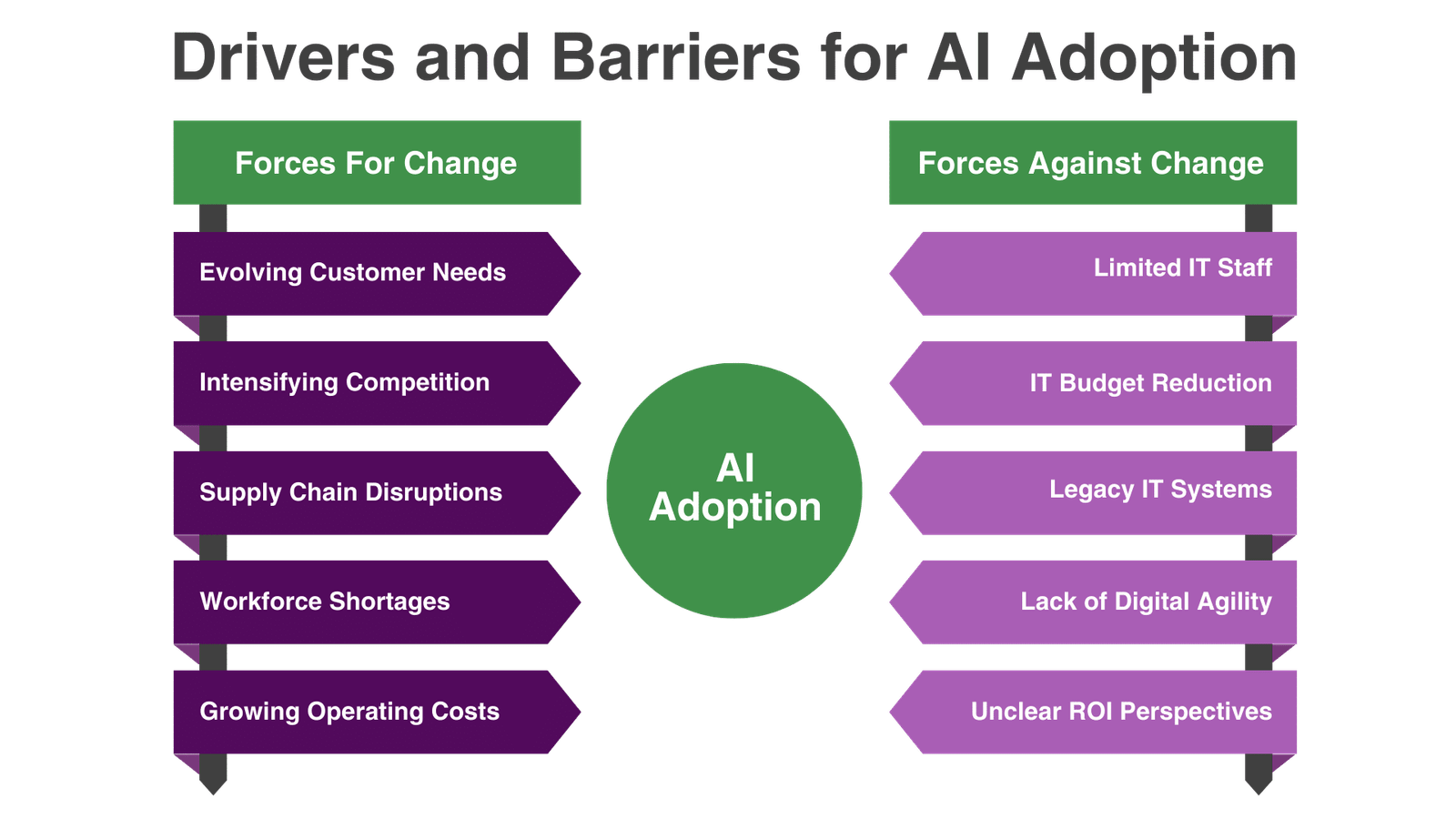The reality is that we’re standing at a crossroads where businesses must decide: Will they be the ones leading the charge into a future shaped by AI, or will they lag behind?
As AI’s influence grows, the gap between leaders and laggards is widening, with those at the forefront reaping significant rewards in efficiency, customer satisfaction, and innovation. Yet, the question remains—how does one navigate this complex process of implementing AI in business to truly transform their industry?
In this detailed guide, we will map out the exact steps that you need to implement AI into your business operations. Therefore, we will cover:
1. What Steps Should Businesses Follow For Efficient Integration of AI?
I. Organizational Level Integration
II. Managerial Level Integration
III. Data Level Integration
2. Why Should Businesses Implement AI into Their Operations?
3. Differentiating AI Leaders and AI Laggards
Discover how integrating AI can streamline your processes and drive growth.
What Steps Should Businesses Follow For Efficient Integration of AI?
Seamless implementation of AI across various levels is crucial for efficiency and data-driven decision-making. Integration at the organizational, managerial, and data levels allows businesses to streamline operations, reduce redundancies, and enhance decision-making processes.
Below are the steps businesses should follow for efficient integration at these three levels:
Organizational Level Integration
At the organizational level, the focus is on aligning the business’s structure, culture, and goals to facilitate seamless integration. Here are the steps involved:
- Align Vision and Goals Across Departments
The first step in organizational integration is ensuring that every department’s goals align with the company’s overarching vision. This can be achieved by revisiting the company’s mission statement and strategic objectives, and then clearly communicating these across the organization. A McKinsey study found that companies with aligned goals are 3 times more likely to achieve above-average profitability, underscoring the importance of this alignment.
- Restructure to Support Integration
Evaluate the existing organizational structure to identify and eliminate any silos that may hinder integration. For example, Deloitte’s 2024 Global Human Capital Trends report revealed that 78% of executives considered organizational restructuring essential for effective integration, with 65% reporting improved agility and responsiveness post-restructure. Restructuring teams to foster cross-departmental collaboration can help dismantle these silos.
- Implement Integrated Communication Systems
Lastly, implementing integrated communication systems ensures seamless interactions across the organization. Gartner’s 2024 report found that companies with unified communication platforms experienced a 30% reduction in internal communication delays, resulting in faster decision-making processes.
Managerial Level Integration
Managerial-level integration focuses on aligning leadership and management practices to support seamless operations and decision-making. The following steps are critical for achieving this:
- Develop Cross-Functional Leadership
Cross-functional leadership is key to breaking down managerial silos. A Harvard Business Review study found that organizations with cross-functional leadership training saw a 25% increase in the successful completion of complex projects. This demonstrates the value of equipping managers to lead across departments effectively.
- Standardize Management Processes
Standardizing management processes ensures consistency across the organization. For example, Siemens implemented standardized project management practices across its global operations, resulting in a reduction in project delays. This step is essential for ensuring smooth and consistent operations.
- Adopt Agile Management Practices
Adopting agile management practices enhances integration by promoting flexibility and quick decision-making. A Project Management Institute (PMI) report found that companies implementing agile practices during integration experienced an improvement in project success rates, showcasing the benefits of this approach.
Data Level Integration for Data-Driven Decision-Making
Data level integration is critical for ensuring that data flows seamlessly across the organization, enabling effective data-driven decision-making. The following steps are essential for data integration:
- Implement a Unified Data Management Platform
Implementing a unified data management platform is the foundation of data integration. A survey found that 62% of organizations with such platforms reported a significant increase in the accuracy of their data-driven decisions. This platform should consolidate data from various sources, providing consistent and accurate information across the organization.
- Integrate Advanced Analytics Tools
Advanced analytics tools, such as AI and machine learning, play a crucial role in processing and analyzing data for decision-making. As a matter of fact, Coca-Cola used AI-driven analytics to optimize its supply chain operations, resulting in a 15% reduction in logistical costs and a 10% increase in delivery speed. These tools help drive more informed decisions.
- Ensure Real-Time Data Accessibility
Real-time data accessibility is essential for timely decision-making. This accessibility ensures that decision-makers always have the latest information about their customer behaviors and market trends to make informed decisions impacting their overall business strategy and capital.
- Promote Data Literacy Across the Organization
Finally, promoting data literacy across the organization ensures that employees can effectively use available data. Gartner’s research shows that companies with high data literacy are 3.1 times more likely to outperform their peers in revenue growth. Offering training programs can help promote data literacy, making data-driven decision-making a core competency across the organization.
Experience the difference AI can make in optimizing your operations and boosting overall success.
Why Should Businesses Implement AI Into Their Operations?
Following are some benefits for businesses of implementing AI into their operations:
1. Streamlining Operations Through Intelligent Automation
One of the most significant advantages of AI is its ability to automate repetitive, manual tasks, thereby freeing up human resources for more strategic activities. Unlike traditional automation, which is rule-based, AI-driven automation can adapt to new scenarios by learning from data and improving over time.
This is particularly evident in industries like logistics, where AI is used to optimize supply chain operations. For example, Maersk, the global shipping giant, has implemented AI to streamline its shipping routes, dynamically adjusting them based on real-time weather conditions and port congestion data. This not only reduces transit times but also cuts fuel consumption, contributing to more sustainable operations.
2. Enhancing Decision-Making with Predictive Analytics
AI’s capacity for data analysis goes beyond what traditional methods can achieve, providing businesses with the ability to make faster, more accurate decisions. AI-driven predictive analytics tools analyze vast datasets to predict trends, forecast outcomes, and suggest optimal strategies. Hedge funds, for example, are increasingly using AI algorithms to process market data and identify investment opportunities before they become apparent to human analysts, resulting in better returns.
3. Revolutionizing Customer Experience with Hyper-Personalization
AI enables businesses to deliver highly personalized customer experiences by analyzing customer data in real time and tailoring interactions accordingly. This hyper-personalization is not just about recommending products but understanding and predicting customer needs with unprecedented accuracy.
One of the innovative approaches to this is seen in the hospitality industry, where luxury hotel chains are deploying AI to anticipate guest preferences before they even arrive. By analyzing data from previous stays, social media activity, and even weather patterns, these AI systems can prepare personalized experiences that enhance customer satisfaction and loyalty.
4. Accelerating Innovation and Reducing Time to Market
AI is a powerful tool for driving innovation, particularly in the research and development (R&D) industry. By automating complex tasks such as data analysis, pattern recognition, and simulation, AI enables businesses to accelerate the development of new products and services.
Companies like Novartis are using AI to model and predict molecular interactions, significantly speeding up the identification of viable drug candidates. This not only shortens the development cycle but also reduces the cost of bringing new drugs to market.
5. Optimizing Operational Efficiency and Resource Management
AI’s role in optimizing operations goes beyond automation to include predictive maintenance, supply chain optimization, and energy management. These applications help businesses reduce waste, lower costs, and operate more sustainably.
For example, in the automotive industry, AI is used to monitor machinery in real time, predicting failures before they occur and scheduling maintenance only when necessary. This approach not only extends the life of machinery but also minimizes production disruptions.
Differentiating AI Leaders from AI Laggards
The difference between AI leaders and AI laggards becomes evident in how they approach AI implementation and the results they achieve. AI leaders like Amazon, Walmart, and others are reaping substantial benefits from AI, driving growth, efficiency, and customer satisfaction. In contrast, AI laggards like Humana may see incremental improvements but often struggle to achieve the transformative impact that AI leaders enjoy.
AI Leaders | AI Laggards |
AI leaders have a strategic vision for AI, in a long-term manner. | AI laggards may adopt AI in a more tactical, short-term manner. |
AI leaders are innovators, constantly pushing the boundaries of what AI can do. | AI laggards often use AI more for maintenance than for innovation. |
Scaling AI across the organization is a hallmark of AI leaders encompassing customer behavior analysis, workforce management, and personalized marketing. | AI laggards often have fragmented AI initiatives that are not integrated across the organization. |
Conclusion:
Integrating AI into your business isn’t just about adopting new technology, it’s about transforming how you operate and positioning yourself for future success. By leveraging AI, you can streamline processes, enhance decision-making, and drive innovation. The journey may seem complex, but with the right strategies and a clear vision, the benefits far outweigh the challenges.






